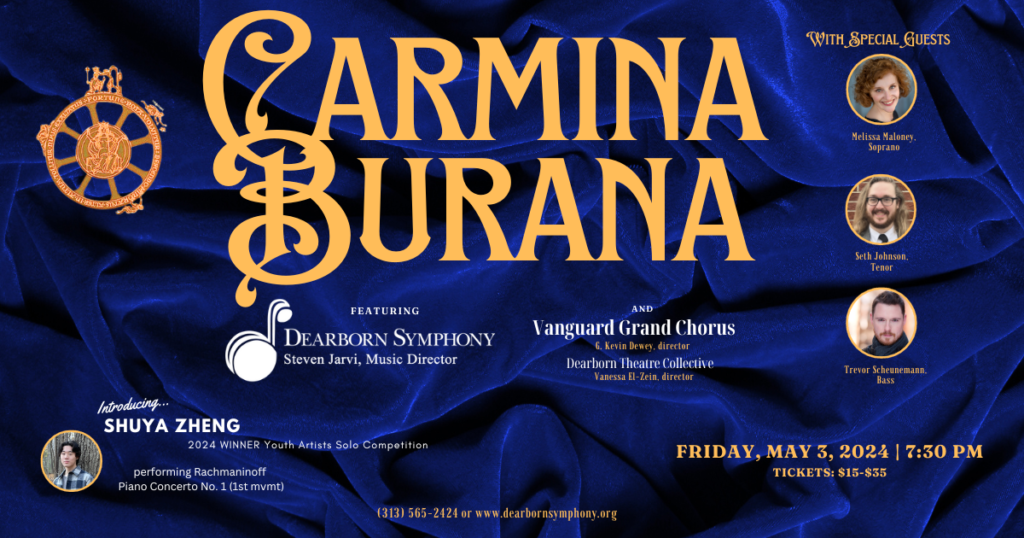Concert begins at 7:30pm. There will be an intermission.

The Dearborn Symphony’s blockbuster 62nd season finale is Friday, May 3 with a veritable feast for the senses, Carmina Burana. Carl Orff’s choral celebration of love, lust and youthful excess in medieval times is as iconic as ever — at once gloriously bawdy and touchingly beautiful. The concert features the Dearborn Symphony joined by over 125 voices including the Vanguard Grand Chorus, directed by G. Kevin Dewey, and the Dearborn Theatre Collective children’s chorus, directed by Vanessa El-Zein. Special guest soloists are Melissa Maloney, lyric coloratura soprano and vocal instructor at Oakland University; Seth Johnson, tenor and private vocal instructor from Perrysburg, OH; and Trevor Scheunemann, baritone and award-winning Metropolitan Opera performer.
Additionally, the 2024 Dearborn Symphony Youth Artists Solo Competition winner Shuya Zheng, a senior from Northville, MI, will open the program performing the first movement of Rachmaninoff’s Piano Concerto No. 1 in F# minor with the orchestra.
PROGRAM
Piano Concerto No. 1 in F# minor, Op. 1, 1st movement
Sergei Rachmaninoff
Shuya Zheng, piano, Winner 2024 Youth Artists Solo Competition
INTERMISSION
Carmina Burana
Carl Orff
Vocalists:
Melissa Maloney, soprano
Seth Johnson, tenor
Trevor Scheunemann, baritone
Vanguard Grand Chorus, directed by G. Kevin Dewey
Dearborn Theatre Collective, directed by Vanessa El-Zein
PROGRAM NOTES
Carmina Burana
Carl Orff
World War I had a profound effect, not only on the world at large, but also on the music world. It would, however, take another twenty years for the full effect to be realized in the classical world.
Carl Orff was a very private man who, aside from a few letters and his work in music education (Orff Schulwerk), we know little about. Born in Munich in 1895, he came from a Bavarian family that had a long history of serving in the German army.
He began studying music at the age of five. He studied composition at the Munich Academy of Music for a short time and his father, a career military officer, would have his regimental band play many of his early compositions.
When war broke out, Carl followed in his father’s footsteps and enlisted in the army where he was injured. While recuperating from his injuries, he became fascinated with theater, and with the music and writings of the 16th and 17th centuries.
In the early 1920’s, he began staging rather imaginative productions beginning with Monteverdi’s “Orpheus”. Then, in 1925, he co-founded the Gunther School in Munich where he further developed his theories of music and movement for children.
All of the above came together in 1937 when he composed his seminal work, Carmina Burana (Songs of the Benediktbeuren).
The text for the work is based on a collection of secular Latin poetry that was discovered in a 12th century monastery, Benediktbeuren, near Munich in 1803. They were written by a group of wandering scholars, writers, clerics, poets and performers, called goliards, who flourished between the 10th and 13th centuries.
The poetry was meant to be understood, so it was written either in vernacular Latin, French or German. It dealt with concerns of the day such as fate, fortune, love and enjoyment and was satirically bawdy and humorous with many delectable double-entendres.
The overall theme of the poetry is that man is the pawn of fickle fate, in life and in love. The front of the manuscript is illustrated with a Wheel of Fortune, which was a common medieval motif. The figures at the principal points of the wheel are labeled I reign, I have reigned, I have no reign, and I shall reign again.
Orff encountered the poems in an 1884 publication by John Addington Symond and selected 24 of the poems to fit into these points. While Carmina Burana is now mostly performed as a concert piece, it was intended as a staged work with dance, costumes, visual design, and plenty of action to highlight the words and music.
The work opens with the well-known, Fortuna, Imperatrix Mundi (Fortune, Empress of the World) to introduce the wheel.
The second section, Primo vere (Springtime) deals with the arrival of spring and thoughts of romance and includes a series of dances. The third section, In Taberna (In the tavern), contains the bawdiest of the poetry as well as the all-time best drinking song. The fourth section, Cours d’amour (The Court of Love), takes us on the long and winding road to love. Finally, the work concludes with a reprise of O, Fortuna as we come full circle on the wheel.
Musically, much of Orff’s Schulwerk theories are present. It is rhythmic, with extensive use of percussion and percussive text. Harmonically, Orff chose to use the most basic of elements: unison, harmonies in thirds and rhythmic or harmonic ostinati. Each musical phrase is short, distinctive and repeated within each section.
The feeling one carries throughout the work is of rhythmically driven energy, however Orff shows his true creativity in the melodies. The melodies are varied, inventive and, mostly, memorable.
The original staging of the work, in Frankfort in 1937, included mime and dance. Over time, the music was recognized as powerful enough to stand on its own, without any visual distractions and is usually performed as a concert work.
Carmina Burana was introduced to mainstream culture by John Boorman in his 1981 film Excalibur. Since then, O Fortuna has been used in, literally, hundreds of films, television and radio programs and advertisements and become somewhat clichéd. Even so, Carmina Burana is a powerhouse work that will continue to be learned, performed, appreciated and loved for decades to come, hitting all four points of the Wheel of Fortune.
-Ava McDowell
Carmina Burana Translation – Click here to view the translation.

Be sure to look through our program book online and patronize our advertisers.
